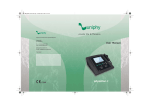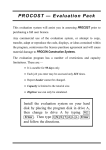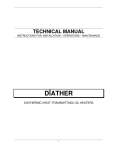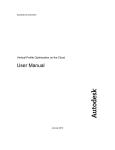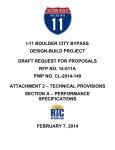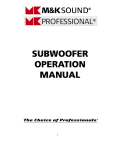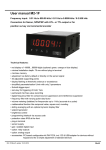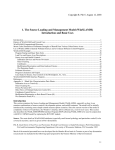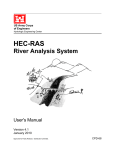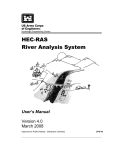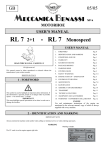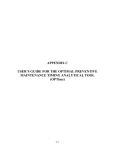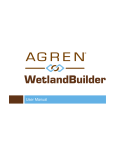Download August 2013 - Ministry of Transportation & Infrastructure
Transcript
August 2013 Highway Planning Cost Estimating System User Manual British Columbia Ministry of Transportation and Highways TABLE OF CONTENTS 1. INTRODUCTION .................................................................................................................................................................... 3 1.1 COST ESTIMATING PRINCIPLES ............................................................................................................................................. 3 1.2 SPREADSHEET FEATURES OVERVIEW................................................................................................................................... 4 2. SPREADSHEET DESCRIPTION......................................................................................................................................... 8 2.1 COLOUR CODING ................................................................................................................................................................... 8 2.2 UNIT RATE / SUMMARY SHEET ............................................................................................................................................. 8 2.2.1 Unit Rate Master List .................................................................................................................................................. 10 2.2.2 Project Costs................................................................................................................................................................ 12 2.2.3 Construction Estimate Summaries ............................................................................................................................. 12 2.2.4 Construction Estimate Breakdown ............................................................................................................................. 13 2.2.5 Road Component Estimated Costs ............................................................................................................................. 13 2.3 ROAD COMPONENT ESTIMATE SHEET ................................................................................................................................ 14 2.3.1 Project Data Input Section.......................................................................................................................................... 14 2.3.2 Calculation Section ..................................................................................................................................................... 14 2.3.3 Construction Cost Estimate Summary........................................................................................................................ 15 2.3.4 Cost Estimate Details by Line Item ............................................................................................................................ 15 3. INTERNAL CALCULATIONS AND SWITCHES .......................................................................................................................... 17 3.1 HIGHWAY STANDARD – URBAN OR RURAL ....................................................................................................................... 17 3.2 TERRAIN TYPES ................................................................................................................................................................... 18 3.3 CUT/FILL VOLUMES ............................................................................................................................................................ 19 3.1.1 New Road Prism Calculations.................................................................................................................................... 19 3.1.2 Existing Road Prism.................................................................................................................................................... 21 3.4 EARTH BALANCE ................................................................................................................................................................. 22 3.5 MISCELLANEOUS ................................................................................................................................................................. 23 4. HOW-TO’S (USING, CHANGING AND MAINTAINING THE SPREADSHEET) ................................................ 24 4.1 HOW TO CHANGE UNIT RATES........................................................................................................................................... 24 4.2 HOW TO ADD OR DELETE LINE ITEMS................................................................................................................................ 24 4.3 HOW TO DEVELOP A BASIC COST ESTIMATE ..................................................................................................................... 25 4.4 HOW TO ADD ROAD COMPONENT ESTIMATE SHEETS ....................................................................................................... 26 4.5 HOW TO ADD EXTERNALLY-CALCULATED INFORMATION ............................................................................................... 27 4.6 HOW TO WORK-AROUND INTERNAL ASSUMPTIONS ......................................................................................................... 28 4.7 ESTIMATING ROAD WIDENINGS (PASSING LANES)............................................................................................................ 28 APPENDIX HPCES1 – SAMPLE COST ESTIMATE DISCLAIMER: The cost estimating system described in this report was developed in 2000 under contract for the Ministry of Transportation and Highways by Kneeshaw Engineering. The author, David Kneeshaw, P. Eng., is currently with McElhanney Consulting Services Ltd. None of these named parties assume responsibility or liability for the accuracy or completeness of the results produced with this system or the consequences of their subsequent use. March, 2000/ August 2013 Page 1 Highway Planning Cost Estimating System User Manual British Columbia Ministry of Transportation and Highways IMPORTANT NOTE: The unit rates and prices contained in these tools are not to be considered current or necessarily applicable for any particular region of the province. It is expected that the unit rates and prices in these tools will be reviewed and updated by the estimator. Estimators must establish their own unit rates and prices in these tools, and ensure they reflect prices prevailing at the time their estimate is prepared. Estimators are fully responsible for the project cost estimates they produce from their use of these tools. March, 2000/ August 2013 Page 2 Highway Planning Cost Estimating System User Manual British Columbia Ministry of Transportation and Highways 1. Introduction This cost estimating system was developed for the Thompson-Okanagan Regional Planning Group, with the intention of providing a simple-to-use cost estimating tool, that would provide straight-forward reports under a wide range of input detail. The spreadsheet was developed in Microsoft Excel. 1.1 Cost Estimating Principles 1.1.1 Unit Rates: This very important aspect of the estimating system should be maintained consistently throughout all of a project’s estimated component parts. It should be easy to follow what unit rates are being used, and also should be easy to update unit rates on a project-wide basis. 1.1.2 Highway Standards: It is important to be able to estimate both rural and urban highway standards. A single project can contain both highway standards, such as a rural highway standard, with and adjacent urban standard frontage road. Estimating capabilities to cover both types of construction are important, with compatible methodology and reporting. 1.1.3 Contingencies: Allowances for contingency amounts should be sensitive to the level of detail in the estimate. As noted earlier, the fixed costs can be estimated quite accurately without much information, variable cost items should allow for more contingencies when less information is known about the site. 1.1.4 Data Input, Calculations, and Cost Estimate Forms: These various types of information should be kept in separate locations in the spreadsheet, in order to maintain integrity of the data. This is especially important as an estimate is updated and improved over time – the estimator needs to have confidence that the formulae are working as he expects, and have not been altered or over-written. The estimator, Quality Control reviewers, management, and future users of the estimate will easily be able to find what data was used in the estimate, and understand the resulting calculated values. There should be no ambiguity regarding the procedure in the estimated quantities. March, 2000/ August 2013 Page 3 Highway Planning Cost Estimating System User Manual British Columbia Ministry of Transportation and Highways 1.1.5 Fixed and Variable Costs: When these types of cost items are identified separately, the estimate provides more accuracy, allows for more optimized contingency amounts and improves the ability to check and compare estimates. Fixed costs include a number of items that are common to almost all highway projects, regardless of the actual location or surrounding terrain conditions. This includes granular and paving quantities, basic drainage requirements, etc. Other fixed items apply to urban conditions such as street lighting, curb & gutter, sidewalk and closed drainage. Although these items can vary somewhat from project to project, they can be calculated quite accurately for any project, without knowing much about site conditions. Variable costs, on the other hand, vary radically from project to project, depending on the site-specific location of the project. Terrain type, design speed, material type (earth vs. rock), existing utilities and other site-specific issues affect the estimated costs dramatically. 1.1.6 Internal Calculations: By incorporating certain assumptions, the estimating system can produce reasonable cost estimates with minimal amounts of information when field data is lacking. The internal calculations should take into account the terrain type and design speed, to estimate earthworks, Concrete Roadside Barrier, and other items. 1.1.7 Externally Calculated Quantities: While the internal calculations can provide the estimator with a certain level of estimating ability, as a project is developed, more information becomes available, which improves the quality of the estimate. Therefore the estimator should have the ability to incorporate externally calculated quantities into the estimate. For example, once computer-calculated cut and fill volumes are available, the estimate should be updated with this information. 1.2 Spreadsheet Features Overview To meet the foregoing estimating principles, this system was developed to incorporate the following features. Detailed descriptions of these features and how they work are included later in the report. March, 2000/ August 2013 Page 4 Highway Planning Cost Estimating System User Manual British Columbia Ministry of Transportation and Highways 1.2.1 Unit Rates: Links pre-defined unit rates to the individual road component estimate sheets. Keeps a master list of unit rates, which can be edited and updated easily. Because of the way the system is linked, changing a single unit rate will be reflected in all individual road component estimates. 1.2.2 Highway Standards: Contains internal “switches” that are recognized by the formulae, which adjust the assumptions to recognize rural and urban design standards. Includes urban features including street lighting, curb & gutter, sidewalk, landscaping, irrigation and utilities including sanitary, storm, water mains. Variable user input will describe the road standard, which can be a simple passing lane addition, to a divided freeway, with a depressed median. 1.2.3 Contingencies: Allows for manual adjustment of any line cost item without overriding the calculated quantity or the standard unit rate. Includes separate contingency rate application to both the fixed and variable portions of each type of construction (site preparation, grading, etc.). Includes a checklist to help assess risk on a project. 1.2.4 Data Input, Calculations, and Cost Estimate Forms: Groups all internal quantity calculations into the calculation area of the spreadsheet. Therefore, no quantity calculations – and only unit and rate extensions – are performed in the Cost Estimate area of the form. Keeps data used in the calculations within the discreet Data Input Area of the Road Component Estimate Sheets. Includes additional space in the Cost Estimate area under the variable cost items for direct user input as required. Codes the type of information by colour, so the estimator maintains an awareness of the types of data within the spreadsheet. March, 2000/ August 2013 Page 5 Highway Planning Cost Estimating System User Manual British Columbia Ministry of Transportation and Highways 1.2.5 Fixed and Variable Costs: Produces summaries of cost estimate results in different formats, for easy comparative reviews. Includes per-kilometre comparisons of fixed and variable costs. Features internal calculations for all fixed cost items, and quantity estimates of earthworks construction in typical terrain types. Lists several other variable cost items, which can be used by direct user input. 1.2.6 Internal Calculations: Includes varying default values for quantities based on typical level, rolling, mountainous terrain definitions, using internal “switches.” Includes a fourth category – “Extreme” – to account for situations such as the removal of an existing rock bluff. Allows for retaining an existing road prism (widening both sides and one side only). WARNING: While using default information can be a useful feature, there are inherent risks involved, as the spreadsheet can provide, a “black box” answer, even when less than sufficient care has been taken in producing an estimate. This is not the intended use for this system. If the estimator relies on the default values when better information is available or can be generated, the quality of the estimate, or at least the confidence in it, suffers. In order to minimize this risk, the estimate sheet provides some indicators as to what input assumptions were used in the estimate. This will help both the estimator and the subsequent users of the information to understand how much confidence can be placed in the estimate, and what kind of detail could be added to improve its accuracy. 1.2.7 Externally Calculated Quantities: Allows input from externally generated earthworks calculations, which will automatically override the internal calculations. March, 2000/ August 2013 Page 6 Highway Planning Cost Estimating System User Manual British Columbia Ministry of Transportation and Highways Uses combinations of internally and externally produced quantity estimates to accommodate ongoing project (and cost estimate) development. 1.2.8 Other System Features: Produces Planning-level cost estimates, with many of the quantities estimated from defined project details. Estimates structural construction – bridges and retaining walls. Includes line items for a number of other special features such as railway crossings, sign bridges, etc. Includes blank lines for project-specific additions. Calculates non-construction project costs such as project management, planning, design/engineering, property acquisition, contingencies, etc. Coordinates with MicroBENCOST analysis: Sets up the total project cost estimate amounts to be compatible with the MicroBENCOST standard input categories. Includes a workbook tab containing the Ministry’s cost discounting spreadsheet. Includes a MicroBENCOST results summary report as an Excel Workbook tab, to keep all financial information in one file. March, 2000/ August 2013 Page 7 Highway Planning Cost Estimating System User Manual British Columbia Ministry of Transportation and Highways 2. Spreadsheet Description This cost estimating system contains two basic spreadsheets, which are highly inter-linked. These two sheets (tabs within one Excel “workbook”) are: Unit Rate / Summary Sheet Road Component Estimate Sheet This system allows as many road components as necessary to be included in the estimate. Adding segments is done by copying the Road Component Estimate Sheet as many times as needed, to cover each road component, then including these segments in the Unit Rate / Summary Sheet. Procedures for doing this are explained in Section 4. Descriptions of the information and use of these two sheets are described below. 2.1 Colour Coding The spreadsheet uses the following colour coding system: Letter (Font) Colour: Green – user input data, used in estimate calculations and also in variable cost items. Red – formula result, both for quantity calculations and unit/rate extensions. These numbers are almost always linked forward into a summation or a summary table. Blue – information that is linked forward to other locations. Grey-blue – linked information that is brought in from another location. Black – spreadsheet form headings, etc. Cell (fill) Colour: Light Yellow – essential user input information Light Green – default over-ride cells Light Grey – contingency percentage 2.2 Unit Rate / Summary Sheet The Unit Rate / Summary Sheet performs three significant roles: March, 2000/ August 2013 Page 8 Highway Planning Cost Estimating System User Manual British Columbia Ministry of Transportation and Highways Holds the Unit Rates Master List. This information is carried forward to all Road Component Estimate Sheets. Reports the results (dollar amounts) of each Road Component Estimate Sheet. Calculates Total Project Costs. Unit Rate / Summary Sheet Project Cost Summary Construction Estimate Summary Construction Estimate Breakdown T o t a l s Unit Rates Master List C o l u m n Road Component Estimated Costs Figure 2.1 - Unit Rate / Summary Sheet Layout Except for calculating the non-construction Project costs and summing the totals, there are no calculations performed by the Unit Rate / Summary Sheet. Essentially it just provides information to the individual estimate sheets, and gathers the results back from those sheets, for reporting purposes. March, 2000/ August 2013 Page 9 Highway Planning Cost Estimating System User Manual British Columbia Ministry of Transportation and Highways There are five distinct sections within the Unit Rate / Summary Sheet as listed below, and illustrated in Figure 2.1. A description of each of these sections follows: Unit Rates Master List Project Costs Construction Estimate Summary Construction Estimate Breakdown Road Component Estimated Costs 2.2.1 Unit Rate Master List Purpose: Contains a master list (Project-wide) of Cost Estimate Line Item descriptions, and their applicable unit rates. These are applied to all of the Project’s road component estimates. Maintaining the link back to this single list ensures that all component estimates are using the same rates consistently for any given project. Activities: The Unit Rate Master List matches, line-for-line, the list found in the Road Component Estimate Sheets. All of the separate Road Component Estimate Sheets in the project are linked to these rates. This inter-relationship is illustrated in Figure 2. 2. Because all cost extensions on the Road Component Estimate Sheets are tied to this master unit rate list in the Unit Rate / Summary Sheet, changing a unit rate in the Unit Rate Master List will change all road component estimates. The effect of a change in any unit rate can be seen “live” as it is changed on the summary page. As cost estimating requirements change, and it becomes necessary to add or delete line items, this is relatively easy to do, but it is important to maintain the integrity of the relationship between the Unit Rate Master List and the Road Component Estimate Sheets. How to do this is explained in Section 4. March, 2000/ August 2013 Page 10 Highway Planning Cost Estimating System User Manual British Columbia Ministry of Transportation and Highways Unit Rate / Summary Sheet Project Costs Construction Estimate Summary Construction Estimate Breakdown T o t a l Unit s Rates Master C List o l u m n Road Component Estimate Sheet 1 Road Component Estimated Costs Road Component Estimate Sheet 2 Road Component Estimate Sheet 3 Figure 2.2 – Interrelationship between Summary and Road Component Estimate Sheets March, 2000/ August 2013 Page 11 Highway Planning Cost Estimating System User Manual British Columbia Ministry of Transportation and Highways 2.2.2 Project Costs Purpose: This is the final calculation and summary of the Total Project Costs. All non-construction project costs are added to the estimate here, categorized to be compatible with subsequent MicroBENCOST analysis. Activities: Brings forward the Construction Costs from the Detailed Summary section of the sheet. Calculates the overall contingency percentage that is added to all construction items for the total Project. Calculates non-construction cost items to determine an estimated Total Project Cost, which is based on percentages of construction costs. These non-construction Project categories are Project Management, Planning, Design, Property, Construction Supervision and Management Reserve. These categories are consistent with the standard MicroBENCOST cost categories: Project Management Planning Design Property Road Construction Structural Construction Construction Supervision Contingency Management Reserve 2.2.3 Construction Estimate Summaries Purpose: To provide summaries of the construction costs by Construction Type (site preparation, grading, paving, etc.). Activities: Brings forward the total estimated cost for each type of construction (site preparation, grading/drainage, paving/ granular, utilities, operational, finishing, special features and structural) as well as property costs and contingency allowances, showing both total and per-kilometre costs for comparison. March, 2000/ August 2013 Page 12 Highway Planning Cost Estimating System User Manual British Columbia Ministry of Transportation and Highways 2.2.4 Construction Estimate Breakdown Purpose: To provide summaries of the construction costs by Cost Type (unit rate calculations, manual adjustments, and contingencies). Activities: Brings forward the Project’s Fixed and Variable construction costs. Indicates the Breakdown showing the influence of any manual adjustments made and contingency allowances. Includes total and per-kilometre costs for each. 2.2.5 Road Component Estimated Costs Purpose: To summarize and summate each line item from each Road Component Estimate Sheet. Activities: Brings forward the Cost total calculated for each line item on the individual Road Component Estimate Sheets. March, 2000/ August 2013 Page 13 Highway Planning Cost Estimating System User Manual British Columbia Ministry of Transportation and Highways 2.3 Road Component Estimate Sheet The Road Component Estimate Sheet is intended to be used with the Unit Rate / Summary Sheet within a defined Project. However, it is also designed to produce a stand-alone construction cost estimate report for the individual road components. There are four distinct sections within the Road Component Estimate Sheet: Data Input Section Calculation Section Construction Cost Estimate Summaries Cost Estimate Details By Line Item A description of each of these sections follows. 2.3.1 Project Data Input Section Purpose: To hold and report the road component input data that are used to calculate estimated quantities. This section also indicates the level of detail that is included in the cost estimate. Activities: The estimator inputs road descriptions, dates, and other general information. The estimator inputs road information that is used in the internally calculated quantity estimates. Displays road component input data that is used to calculate a number of the project quantities. 2.3.2 Calculation Section Purpose: All internal quantity estimate calculation formulae are contained in this section. These calculations draw only on information contained in the data input section. Activities: Internal calculation formulae, assumptions and “switches” that toggle from one assumption to another are contained in this section. Detailed explanations of the internal calculations are described later in Section 3. March, 2000/ August 2013 Page 14 Highway Planning Cost Estimating System User Manual British Columbia Ministry of Transportation and Highways 2.3.3 Construction Cost Estimate Summary Purpose: To provide a summary of fixed and variable costs for the Road Component. Activities: Carries forward the subtotals contained in the detailed line item estimates. Shows the breakdown for amounts estimated through unit costs, manual adjustments and contingencies. Reports the costs, broken down as noted above, for each type of construction – site preparation, grading/drainage, paving/ granular, utilities, operational, finishing, special features, as well as property estimates. Costs apportioned to Fixed and Variable Items are separated for comparison. Total and per-kilometre costs for the road component are displayed. 2.3.4 Cost Estimate Details by Line Item Purpose: This section holds all the details of the line items, which form part of the total estimated cost. This includes unit rate calculations, manual adjustments, and the assignment of contingency rates. Activities: All cost extensions are tied to this master unit rate list in the Unit Rate / Summary Sheet, therefore changing a unit rate in this section has no effect on the estimate – the unit rate needs to be changed in the Unit Rate Master List to update the cost estimate. As for the unit rates, the cost item descriptions are also linked back to the Master Unit Rate List. Changing a description in the master list therefore updates it for all individual estimates. Manual adjustments are made to any line item in this section, as a dollar figure. This allows individual contingencies or other corrections to be applied to any line item. These adjustments can be positive or negative. Note that the manual adjustment amounts are included when the contingency rate is applied. User-defined contingency percentages are established uniquely not only for each type of construction, but also for the fixed and variable portions of each type of construction. March, 2000/ August 2013 Page 15 Highway Planning Cost Estimating System User Manual British Columbia Ministry of Transportation and Highways Additional items, for which no line item or unit rate is included in the spreadsheet, can be simply added to the cost estimate in the blank lines under Special Features/Other, without modifying the Unit Rates Master List or any external linkages. This is the only case where the description and unit rate should be entered directly to the Road Component Estimate Sheet. The formulae for these items work locally and are not linked to the Master Unit Rate List. The line item descriptions cannot be displayed in the Project Summary, but the dollar figure is carried forward into the summaries. Road Component Estimate Sheet Data Input Area Calculations Area Construction Cost Estimate Summary Line Item Details, variable item inputs, Manual Adjustments, Contingency Adjustments Figure 2.3 - Road Component Estimate Sheet Layout March, 2000/ August 2013 Page 16 Highway Planning Cost Estimating System User Manual British Columbia Ministry of Transportation and Highways 3. Internal Calculations and Switches As noted in Section 1.2, along with the related warning, a number of internal default values are included in the spreadsheet in order to produce cost estimates with very limited information. These estimates can be produced for urban or rural road standards, different terrain types, and varying design speeds. To accommodate various conditions, there are three types of “switches” built in to the various formulae in the spreadsheet. These are: Highway Standard (rural or urban) – set by a single cell entry. Terrain Type – set by a single cell entry. Earthworks calculations (internal or external) – works through a number of scenarios; estimate parameters are set by multiple cell entries, depending on the input data available. While not considered switches, design speed and road width are factors used in the earthwork calculation algorithms. Tables 3.1to 3.3 outline the various default assumptions that are incorporated into the internal calculations, whether they are sensitive to, or toggled by, the “switches,” and the effect of the toggling. 3.1 Highway Standard – Urban or Rural The following Table 3.1 outlines the effect of the Urban or Rural Highway standards on the various cost estimate items. For example, when the Highway Standard Switch is set to Urban, the spreadsheet includes calculations for concrete curb and gutter, catchbasins, luminaires, additional pavement area for intersections, and changes the earth prism requirements accordingly. Resetting this switch to Rural would automatically remove or reset these items in accordance with the predefined assumptions. March, 2000/ August 2013 Page 17 Highway Planning Cost Estimating System User Manual British Columbia Ministry of Transportation and Highways TABLE 3.1 – Switch Settings for “Highway Standard” Cost Estimate Item(s): Curb and Gutter Sidewalk Catchbasins Switch setting: Urban 2 * (project length) 1 * (project length) (Curb & gutter) / (specified spacing) plus additional None 1 * (project length) None Switch setting: Rural None None (CRB + asphalt curb) / (specified spacing) + additional Asphalt Curb Inc. spillways etc. 15% of project length Storm Sewer including MH’s None Minor Culvert Crossings, Major (project length) * (specified Culvert Crossings number per km) Subgrade Prep., Subbase (SGSB), Area based on urban crossArea based on rural crossGranular Base (WGBC) section (see figure 3.1) section (see figure 3.1) Based on all pavement areas Hot Mix Asphalt (HMA) Based on all pavement areas input increased 5% for urban fillets input etc. New/Relocated Luminaires (project length) / (specified None (plus additional) spacing) plus additional Augment & Place Topsoil (3m strip) * (specified depth) * 2 (10m strip) *(specified depth) *2 [i.e. both sides of project] [i.e. both sides of project] Hydroseeding None 7.5m each side of subgrade Planting and Irrigation, L/S Structures 3m wide each side of subgrade * None & Furnishings project length Strip & Stockpile Topsoil (3m wide strip) * (project length) * (10m wide strip) * (project (specified depth) both sides length) * (specified depth) both sides Earthwork height of subgrade If Terrain Type E or M then Hn=0, Refer to Table 3.2 if R then Hn=0.8, if L then Hn=0.6 CRB, CDB, CMB None CRB, CDB per Table 3.2, CMB per Table 3.5 Pavement Structure Curb & Gutter Sidewalk(s) Pavement Width Subgrade Width Pavement Structure Pavement Width Hn Rural Cross-Section Hn Subgrade Width Urban Cross-Section Figure 3.1 – Urban and Rural Road Prism Cross-Section March, 2000/ August 2013 Page 18 Highway Planning Cost Estimating System User Manual British Columbia Ministry of Transportation and Highways 3.2 Terrain Types The terrain type affects the calculation quantities for earthwork and other quantities as noted in Table 3.2. For rural highway standards, the design speed and roadway width are also combined with the terrain type in the earthworks calculations to vary the area of the calculated road prism. These combinations provide a wide range of possible earthworks quantity estimates. For urban highway standards, the subgrade height remains constant for Rolling and Level Terrain. The spreadsheet will return a “N/A” area if either Extreme or Mountainous Terrain are combined with an urban standard. TABLE 3.2 – Switch Settings for "Terrain Type" Cost Estimate Item: Switch Default Value Value E project length *110% CRB/CDB (in addition to CMB noted in Table 3.3) Switch Default Value Value R project length *30% M project length *75% L none E Hn = 30, also embankment quantities set to zero Hn = 2.5 * (1 + (Design Speed - 70) * 2 / 100) R Hn = 1.5 * (1 + (Design Speed - 80) * 2 / 100) Hn = 1 * (1 + (Design Speed 90) * 2 / 100) 95% of the total Exc. 40% of the total Exc. R L 25% of the total Exc. 0% of the total Exc. R (Project Length * 10% * 3m high) Type D – Earth excavation to embankment (subgrade height)** M Type A – Rock excavation to embankment E M Lock Block Retaining Wall M (Project Length * 25% * 5m high) Note: **Further explanation of default values in Table 3.3. L 3.3 Cut/Fill Volumes 3.1.1 New Road Prism Calculations All internally calculated earthworks (and some other items) are based on an assumed new roadway prism. The key value in this is the height of subgrade fill. This is illustrated in Figure 3.2 below. The default values for the calculated earthwork prism are listed below in Table 3.3. This method must be viewed as only a rough method for approximating earthworks. The logic for the method is not sound for a number of reasons, including the lack of consideration for cut conditions such as side hill steepness (original ground is always considered to be level), ditch geometry, etc. While the spreadsheet has March, 2000/ August 2013 Page 19 Highway Planning Cost Estimating System User Manual British Columbia Ministry of Transportation and Highways some correction factors built in to account for these problems, it is noted that they are described as a “theoretical corrections applied to a rough approximation.” Ignoring these logistics, however, the method can provide reasonable “first cut” approximations of total earthworks and other item quantities. The correction factors noted above are explained in Table 3.4 below. Pavement Structure Subgrade Original Ground (after stripping) Hn Figure 3.2 – Theoretical New Road Prism Cross-Section TABLE 3.3 – "Terrain Type" Default Assumptions Terrain Type E - Extreme M - Mountainous R - Rolling L - Level Subgrade Height 30 metres 2.5 metres 1.5 metres 1 metre Design Speed N/A 70 km/h 80 km/h 90 km/h Road width 12 metres 12 metres 12 metres 12 metres Other items affected by the New Road Prism assumptions include: Culvert lengths are equal to the road prism’s base width. Stripping, clearing and grubbing areas are based on the road prism’s base width. March, 2000/ August 2013 Page 20 Highway Planning Cost Estimating System User Manual British Columbia Ministry of Transportation and Highways TABLE 3.4 – Earthwork Adjustments Design Parameter Adjustment 1. Design Speed (Profile issue) – Adjustment applied to Subgrade height E – Extreme N/A M – Mountainous 2 * (percent difference from default speed) R – Rolling 2 * (percent difference from default speed) L – Level 2 * (percent difference from default speed) 2. Number Lanes (Cross-section issue) - Adjustment applied to Road Prism Area E – Extreme N/A M – Mountainous 15% increase to prism area per lane additional to default R – Rolling 5% increase to prism area per lane additional to default L – Level N/A 3.1.2 Existing Road Prism This system allows for the retention of an existing roadway prism within the new road prism, in the event that the project is a road widening, such as the addition of a new passing lane(s), as illustrated in Figure 3.3, or reconstruction of an existing highway, Figure 3.4. Added Highway Width Existing Highway He Hn Figure 3.3 – Widening Existing Road Prism Procedures for estimating highway widening are contained in Section 4.7. In the case of highway reconstruction, Effective length – often the highway is realigned to improve design speed or to avoid site constraints. In such cases, the new road prism may March, 2000/ August 2013 Page 21 Highway Planning Cost Estimating System User Manual British Columbia Ministry of Transportation and Highways not encompass the old roadway continuously. Therefore, this condition can be applied for only part of the new road’s length. The existing highway prism affects two other items: pavement removal and the topsoil stripping (the stripping width is reduced by the width of the existing road top). Calculations for these two items are applied to the full length of the new road segment, regardless of the effective length of the overlapping road prisms as noted above. It is assumed that if an existing road exists anywhere within the right-of-way, that it will extend the full length of the new roadway, and will require rehabilitation. New Highway Prism Pavement Structure Existing Highway Prism Subgrade He Hn Figure 3.4 – Existing Road Prism – Reconstruction 3.4 Earth Balance An equal volume to the embankment quantity calculated above is also assumed as an excavation quantity, resulting in a theoretically balanced earth situation for the mountainous, rolling, and level terrain categories. This balance is then affected by estimated rock quantities, shrinkage factors, and unsuitable material estimates. March, 2000/ August 2013 Page 22 Highway Planning Cost Estimating System User Manual British Columbia Ministry of Transportation and Highways For the extreme category, zero embankment quantity is assumed, resulting in all excavated material (assumed to be 95% rock) being wasted. The overall excavation quantity (including subcut material) is assumed to be Type D material, except for the percentages of Type A (rock) and unsuitable material. Shrinkage and swell of Type D and Type A materials is applied; then the amount of borrow and waste required to balance the cuts and fills is included in the estimates. The earth balance calculations remain active when externally calculated values are included in the estimate, and are more important at that time, as the actual balance of material can then be evaluated with more confidence. 3.5 Miscellaneous Catchbasins and Luminaires have two types of estimated entries: a specified spacing, and an “additional” number. It is possible to use either, or both of these estimation methods, as explained below. The specified spacing will be used to calculate a number of catchbasins over the total length of curb and gutter, or in rural areas, at the same spacing along the CRB and asphalt curb lengths. If this spacing is set to zero, no catchbasins will be estimated on the standard spacing basis, and only the “additional catchbasins” will be included. Similarly, luminaires will be estimated based on the specified spacing, unless this is set to zero, in which case only the “additional luminaires” will be included in the estimate. TABLE 3.5 - Other Internal Calculation Assumptions Cost Estimate Item: Asphalt Removal Remove Trees/Grubbing Signing Costs, Pavement Markings CMB Relocate Utility Poles Assumption: exist road top width * project length area calculated for stripping lane-km based on (average pavement width) / 5 if median >2.6m wide, CMB assumed equal to median length based on 150m spacing Notes: Stripping quantities: Existing road top width removed from stripping area March, 2000/ August 2013 Page 23 Highway Planning Cost Estimating System User Manual British Columbia Ministry of Transportation and Highways 4. How-To’s (Using, Changing and Maintaining the Spreadsheet) 4.1 How To Change Unit Rates Unit rates are time sensitive, and depend on the general state of the economy, and are affected by the cost of labour, supplies and materials. It will be necessary to update these unit rates from time to time, to keep the estimates current. This system allows previously estimated projects to be completely updated instantly, just by updating the unit prices. Master Unit Rate List: simply type the new unit rate over the old one and all existing Road Component Estimate Sheets will be updated automatically. If a number of unit rates are being updated with a significant number of unit rate changes, the new list can be pasted over the old values in one step. When doing this, however, it is imperative that the line items have not been altered (see below), or if they have, that they are exactly the same in all spreadsheet tabs. Change in the Road Component Estimate Sheet (not recommended): it is possible to change a unit rate for a line item in only one component of the job. This requires the estimator to type the new unit rate over the old one, and change the unit / rate extension formula to utilize the new rate instead of linking back to the Unit Price Master List. This may apply, for an example, if a certain type of construction in this area were expected to be negotiated after tendering. However, even in this case, it would be better to add this as a new line item and estimate this separately, otherwise the change will be hard to find later, and the tender quantities will not be accurate when creating the Schedule 7 cost estimate. 4.2 How to Add or Delete Line Items The intention of the spreadsheet line items is to include the items that are common to most projects, and allow for additional, project specific items to be added as required. Therefore, it is usually easier to just add the unusual items into the blank lines in the Special Features/Other category than to add line items into the spreadsheet. On the other hand, if the estimator finds that most projects include wildlife fencing for example, this could be added to the spreadsheet as a permanent feature. March, 2000/ August 2013 Page 24 Highway Planning Cost Estimating System User Manual British Columbia Ministry of Transportation and Highways Note that the change needs to be made in both the Unit Rate / Summary Sheet and the individual Road Component Estimate Sheet. To add a cost estimate line item follow these steps: Click on summary “Summ” tab. Select a work category for the new item. Insert a blank line. Click on the “Road1” tab. Insert a blank line below the same line item as in the summary sheet (insert in middle of list if possible to avoid lines with contingency entries and also the summation formulae then will adjust automatically). Copy all cells from any other line into the new blank line (this will copy the linked references). Click on “Summ” tab. Copy all cells from any other line into the new blank line (this will copy the linked references). Type the new item description, units, and unit rate. Click on the “Road1” tab, check that the contingency and totals formulae are working properly. Enter the quantity for your new item – it will be included in the totals and summaries on both sheets. If you have already created more than one Road Component Estimate Sheet, insert the line and copy the formulae from another line in all of these (hint - the “insert copied cells” function will do this in one step within each sheet). 4.3 How to Develop a Basic Cost Estimate The minimum amount of user input information required to create an estimate are the project’s beginning and ending stations (project length), terrain type, highway standard, design speed, and number of lanes. The spreadsheet will then use default values to calculate a number of other items. In the data input section of the “Road1” tab, a number of the entry cells contain the letter “D”. These are the input items that have default values available when the actual information is not available to the estimator. If more detail is available, or becomes available, it can be added into the various data input cells by typing the values over these D’s. The spreadsheet will then use the entered information in preference to the March, 2000/ August 2013 Page 25 Highway Planning Cost Estimating System User Manual British Columbia Ministry of Transportation and Highways default values. It is assumed that any values entered in this way will be more accurate than the default values, as they will have been determined with the benefit of the estimator’s intelligence and project knowledge, whereas the default values are generic. 4.4 How to Add Road Component Estimate Sheets The basic cost estimate system consists of two sheets – the Unit Rate / Summary Sheet (tab named “Summ”), and the Road Component Estimate Sheet (tab named “Road1”). To develop an estimate with multiple components, the estimator must add sheets for each roadway component by copying the default (or any other) sheet, and combining them into the summary report. There are two steps (with several substeps) to doing this as follows: Copy new Road Component Estimate Sheet and input data: Right-click on the “Road1” tab. Click on the “move or copy” option. Set to “before” then highlight “Discount.” Click on the “make copy” box. Click on OK to make new sheet. Right click on the new tab “Road1 (2)” Click on “rename” option Type in Road2 Input road information for this road component. Add column into the Unit Rate / Summary Sheet. Click on the “Summ” tab. Right-click on the column letter (K) for the Road1 summary information to highlight the whole column, choose the “copy” option. For the first five additional road components, just paste the copied cells these into the next available column (L, M, N, O or P). If you are producing a seventh road component column, you will need to choose “Unprotect sheet” from the “Tools” menu. Then, right-click the right column (O – initially); this column is narrow, and coloured blue. Choose the “insert copied cells” option. (Note turning off the worksheet protection means that any cell can be over-written.) Highlight the new column, find and replace all “Road1” references with “Road2” by typing CTL-F, “Road1”, ALT-R, [tab], “Road2”, then click the “Replace all” option. (Hint – try the “find next” and “Replace” before using the “Replace all” March, 2000/ August 2013 Page 26 Highway Planning Cost Estimating System User Manual British Columbia Ministry of Transportation and Highways option, as if you made a typo, an error message comes up for every wrong reference and therefore about 100 escape key strokes are required.) Repeat this procedure for each road component to be added. 4.5 How to Add Externally-Calculated Information As noted above, the spreadsheet uses a number of default values to estimate earthworks and other quantities. Information that can be added to an estimate, but which will use default values in the absence of user input contain a “D”. The estimator can over-ride any of the internal default values in favour of better information by simply typing the values to replace the “D’s”. This also clearly indicates what information the estimator has entered. The default information formulae are not lost, even when inputting the externally calculated information, and can be restored simply by replacing the input value with a “D”. Earthworks – The internal earthwork calculations are quite complex, and several options are available to over-ride the defaults completely, or only partially. The following steps would be taken, generally in the order listed, to include externally calculated information in the estimate. As these steps are taken, the indicator flags for the earthwork assumptions will change from “OK” to “N/A”, as these assumptions are over-ridden. Input a Height of Fill value (higher or lower than default shown) to approximate external calculations. Input actual embankment adjusted and excavation quantities (adjusted for shrinkage) from external calculations. At this level of detail the program will retain the use of internally calculated stripping, clearing and grubbing quantities, percent rock and topsoil placing assumptions. Input the calculated stripping quantity. Input the calculated rock quantity. Input the calculated topsoil placing quantity. There are many variable cost items that are included in the spreadsheet that do not have associated default values – the estimator must input the appropriate values for any of these project-specific items. This also applies to any line items that may need to be added to the spreadsheet, as noted above. March, 2000/ August 2013 Page 27 Highway Planning Cost Estimating System User Manual British Columbia Ministry of Transportation and Highways 4.6 How to Work-Around Internal Assumptions There are a number of items that will be included in an estimate as default quantities, even after some externally calculated information has been incorporated, such as CRB, catchbasins, asphalt curb, etc. It will be necessary in some cases to remove or change these quantities from the estimate. This is done by replacing the “D” in the input cells to zero or any other applicable number. To revert back to the default values, the estimator simply types the “D” back into the appropriate cell. 4.7 Estimating Road Widenings (Passing Lanes) There are many situations where the project consists of a passing lane, which may be tacked on to the side of the existing highway. The spreadsheet can account for this, by using the existing road prism entries as follows (refer to figure 3.3). Note when two passing lanes are being added for opposite directions of travel in the same location, it is recommended to estimate these as two separate road components. Set existing Road width to zero. (This creates a triangular shaped existing road prism, which will fit inside the new road prism, thus removing this triangular area from the net prism area. This also sets pavement removals to zero.) Set He equal to Hn. (This sets the new subgrade height equal to the top of the triangle described above, to ensure the triangle fits within the new prism.) Set sideslope steepness equal for new and existing. (This effectively establishes the widening prism as a parallelogram). Set new pavement sidelope to 0:1. (This will provide a parallelogram shape for granular materials. March, 2000/ August 2013 Page 28 Highway Planning Cost Estimating System User Manual British Columbia Ministry of Transportation and Highways APPENDIX HPCES1 - SAMPLE COST ESTIMATE 1. Summary / Unit Rate Sheet [3 pages] 2. Risk Assessment Worksheet [1 page] 3. Road Component Estimate Sheets (2) [4 pages] 4. Cost Discounting Worksheet [2 pages] 5. MicroBENCOST Results Summary [1 page] March, 2000/ August 2013 Page 29






























![1127117 - [PROJECT.TOC] - Performance Heating & Plumbing](http://vs1.manualzilla.com/store/data/005895106_1-55e9d6c83dbc31a8ba61d6bb401245cf-150x150.png)

